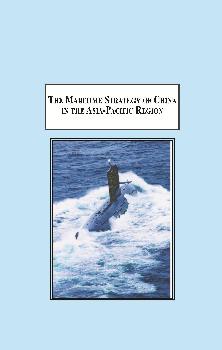This is our backup site. Click here to visit our main site at MellenPress.com
THE MARITIME STRATEGY OF CHINA IN THE ASIA-PACIFIC:
Origins, Development and Impact

| Author: | An-hao Huang, Paul | |
| Year: | 2010 | |
| Pages: | 484 | |
| ISBN: | 0-7734-1332-4 978-0-7734-1332-0 | |
| Price: | $279.95 | |
This research aims to examine how and why a continental-oriented China has shifted its maritime strategic orientation and naval force structure from its coast toward the far seas in an era of interdependent international system. Generally, China is an ancient continental land power with an incomplete oceanic awareness. With the transformation after the Cold War of China’s grand strategy from landward security to seaward security, maritime security interests have gradually become the most essential part of China’s strategic rationale. This book contains six color maps.
Reviews
“. . . makes an important contribution to the study of China’s maritime strategy.” – Prof Derek McDougall, University of Melbourne
Table of Contents
ACKNOWLEDGMENTS
ABBREVIATIONS AND ACRONYMS
Chapter 1 Introduction
1.1 Context Analysis
1.2 Question Statement
1.3 Research Proposition
1.4 Methodology
1.5 Comparison of Relevant Concepts
1.6 Definition of Terms
Chapter 2 Literature Review
2.1 Approaches of Chinese Strategic Studies: Structural Realism vs. Strategic Culture
2.2 Chinese Grand Strategy and Sea Power
2.3 China’s Maritime Strategy and the PLA Navy
2.4 Summary
PART I ORIGINS
Chapter 3 Weltanschauung, Grand National Strategy, Strategic Culture and Nationalism
3.1 Chinese Weltanschauung: Past and Present
3.2 China’s Grand National Strategy and Its Rising Sea Power
3.3 Chinese Strategic Culture and Military Theory toward the Sea
3.4 The Influence of China’s Nationalism on Its Maritime Strategic Orientation
3.5 Summary
PART II DEVELOPMENT
Chapter 4 Coastal Defence
4.1 Political Analysis: Land-Oriented Grand Strategy and Coastal Defence
4.2 Economic Analysis: Maoist Economic Development and Self-Sufficiency
4.3 Socio-cultural Analysis: Party/Army Relations and Techno-Nationalism
4.4 Military Analysis: Capabilities and Operations of the PLAN
4.5 Summary: Strategic Appraisal of China’s Coastal Defence
Chapter 5 Offshore Defence
5.1 Political Analysis: Emerging Sea-oriented Grand Strategy and Maritime Defence
5.2 Economic Analysis: China’s Ocean Frontier and Its Rising Maritime Economy
5.3 Socio-cultural Analysis: Civil-Military Relations, Pragmatic Nationalism and Ocean Consciousness 2
5.4 Military Analysis: Offshore Active Defence, Capabilities and Operations of the PLAN
5.5 Summary: Strategic Appraisal of China’s Offshore Active Defence
Chapter 6 Aspiration for Far Sea Defence
6.1 Political Analysis: China’s Emerging Strategic Objective of Sea Power Status
6.2 Economic Analysis: The Top Strategic Priority of Economic Security
6.3 Socio-Cultural Analysis: Maritime Soft Power under China’s Charm Offensive
6.4 Military Analysis: ‘Aircraft-Carrier School’ vs. ‘Submarine School’
6.5 Summary: Appraisal of China’s Blue-Water Maritime Strategic Ambition
PART III IMPACT
Chapter 7 The Impact of China’s Expanding Maritime Strategy on Maritime Security in the Asia-Pacific
7.1 Determining the Changing Distribution of Regional Strategic Equilibrium
7.2 Potential Threat to Regional Maritime Economic Energy Security
7.3 Accelerating the Emergence of Potential Regional Navalism
7.4 Challenges to Maritime Security Building
7.5 Summary
Chapter 8 Conclusion
8.1 Succeeding Zheng He’s Historical Voyages
8.2 Expanding China’s Maritime Leverage
APPENDICES
Appendix A: The Map of China’s Two-Island Strategy
Appendix B: The Location of Paracel and Spratly Islands in the South China Sea
Appendix C: The Location of Senkaku/Diaoyutai Islands
Appendix D: The Map of China’s Sea Routes
Appendix E: China’s Naval Units
Appendix F: Countries Claiming Ownership in the South China Sea
BIBLIOGRAPHY
INDEX
ABBREVIATIONS AND ACRONYMS
Chapter 1 Introduction
1.1 Context Analysis
1.2 Question Statement
1.3 Research Proposition
1.4 Methodology
1.5 Comparison of Relevant Concepts
1.6 Definition of Terms
Chapter 2 Literature Review
2.1 Approaches of Chinese Strategic Studies: Structural Realism vs. Strategic Culture
2.2 Chinese Grand Strategy and Sea Power
2.3 China’s Maritime Strategy and the PLA Navy
2.4 Summary
PART I ORIGINS
Chapter 3 Weltanschauung, Grand National Strategy, Strategic Culture and Nationalism
3.1 Chinese Weltanschauung: Past and Present
3.2 China’s Grand National Strategy and Its Rising Sea Power
3.3 Chinese Strategic Culture and Military Theory toward the Sea
3.4 The Influence of China’s Nationalism on Its Maritime Strategic Orientation
3.5 Summary
PART II DEVELOPMENT
Chapter 4 Coastal Defence
4.1 Political Analysis: Land-Oriented Grand Strategy and Coastal Defence
4.2 Economic Analysis: Maoist Economic Development and Self-Sufficiency
4.3 Socio-cultural Analysis: Party/Army Relations and Techno-Nationalism
4.4 Military Analysis: Capabilities and Operations of the PLAN
4.5 Summary: Strategic Appraisal of China’s Coastal Defence
Chapter 5 Offshore Defence
5.1 Political Analysis: Emerging Sea-oriented Grand Strategy and Maritime Defence
5.2 Economic Analysis: China’s Ocean Frontier and Its Rising Maritime Economy
5.3 Socio-cultural Analysis: Civil-Military Relations, Pragmatic Nationalism and Ocean Consciousness 2
5.4 Military Analysis: Offshore Active Defence, Capabilities and Operations of the PLAN
5.5 Summary: Strategic Appraisal of China’s Offshore Active Defence
Chapter 6 Aspiration for Far Sea Defence
6.1 Political Analysis: China’s Emerging Strategic Objective of Sea Power Status
6.2 Economic Analysis: The Top Strategic Priority of Economic Security
6.3 Socio-Cultural Analysis: Maritime Soft Power under China’s Charm Offensive
6.4 Military Analysis: ‘Aircraft-Carrier School’ vs. ‘Submarine School’
6.5 Summary: Appraisal of China’s Blue-Water Maritime Strategic Ambition
PART III IMPACT
Chapter 7 The Impact of China’s Expanding Maritime Strategy on Maritime Security in the Asia-Pacific
7.1 Determining the Changing Distribution of Regional Strategic Equilibrium
7.2 Potential Threat to Regional Maritime Economic Energy Security
7.3 Accelerating the Emergence of Potential Regional Navalism
7.4 Challenges to Maritime Security Building
7.5 Summary
Chapter 8 Conclusion
8.1 Succeeding Zheng He’s Historical Voyages
8.2 Expanding China’s Maritime Leverage
APPENDICES
Appendix A: The Map of China’s Two-Island Strategy
Appendix B: The Location of Paracel and Spratly Islands in the South China Sea
Appendix C: The Location of Senkaku/Diaoyutai Islands
Appendix D: The Map of China’s Sea Routes
Appendix E: China’s Naval Units
Appendix F: Countries Claiming Ownership in the South China Sea
BIBLIOGRAPHY
INDEX
